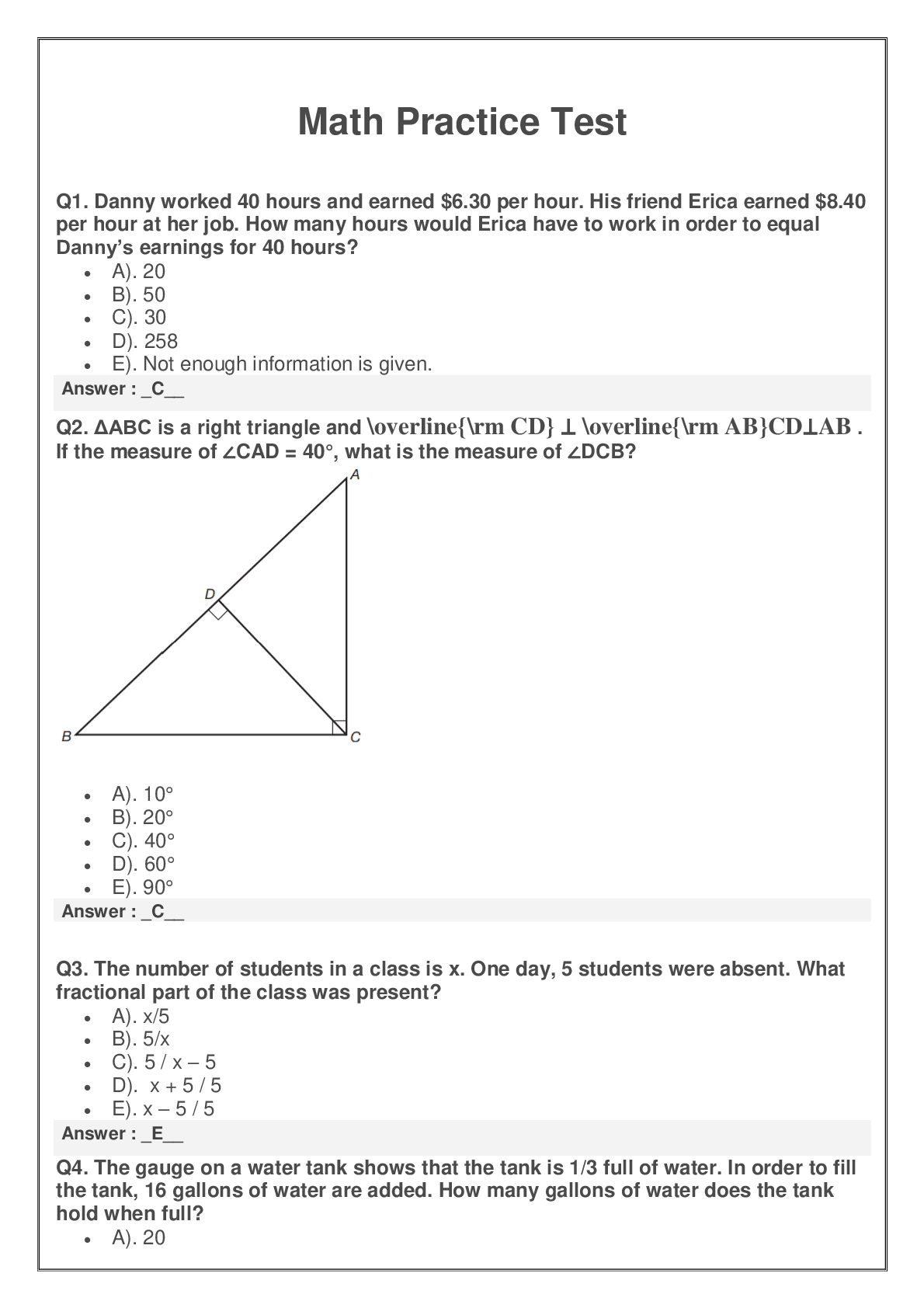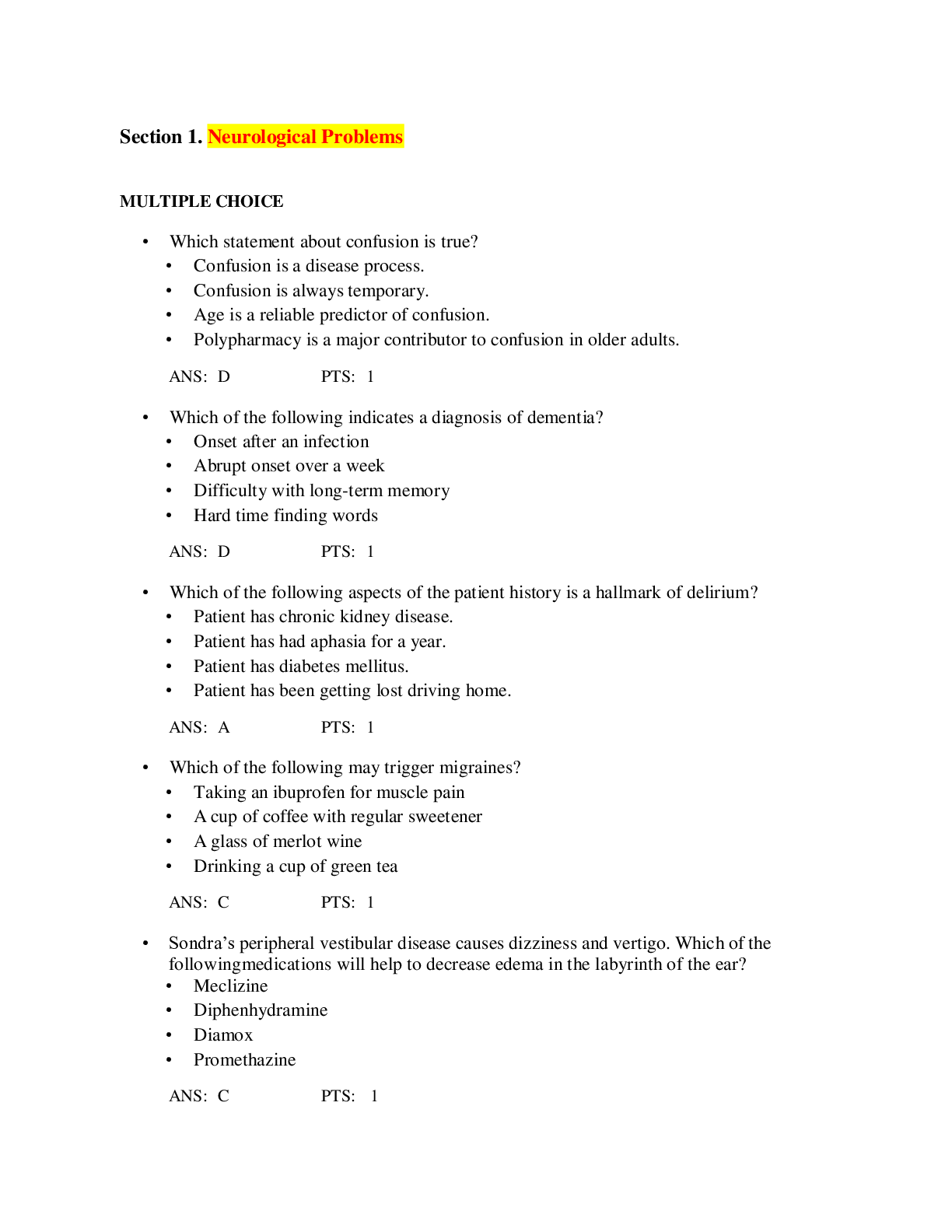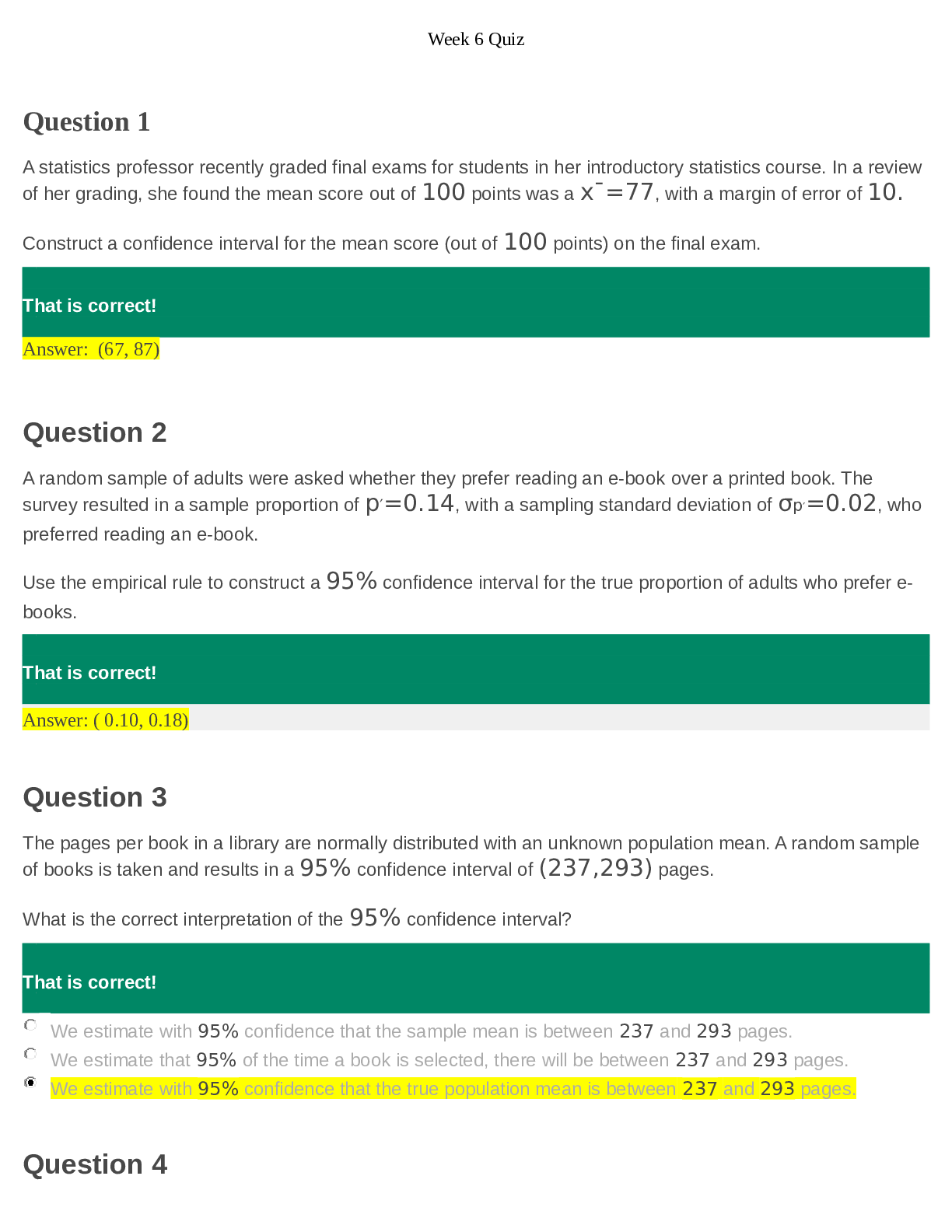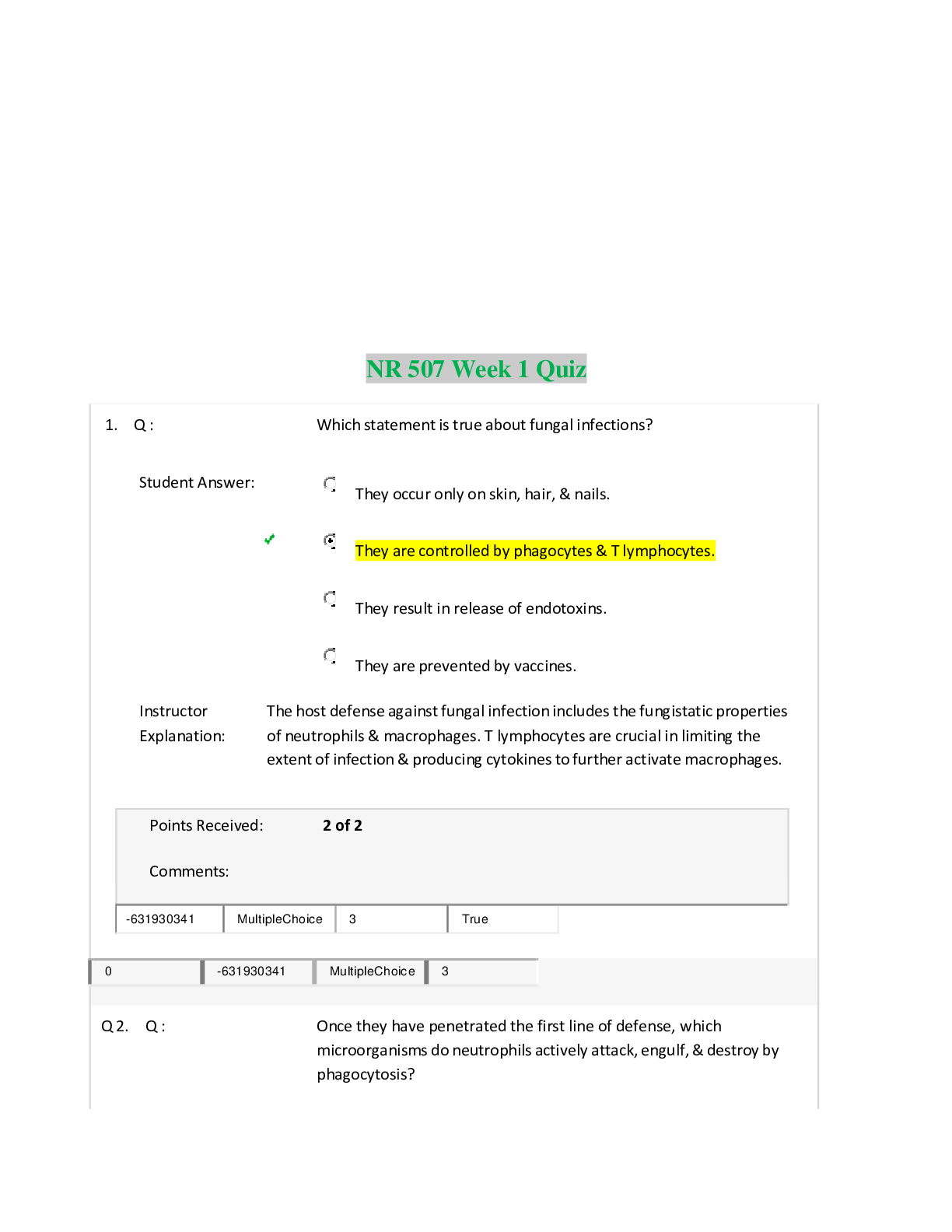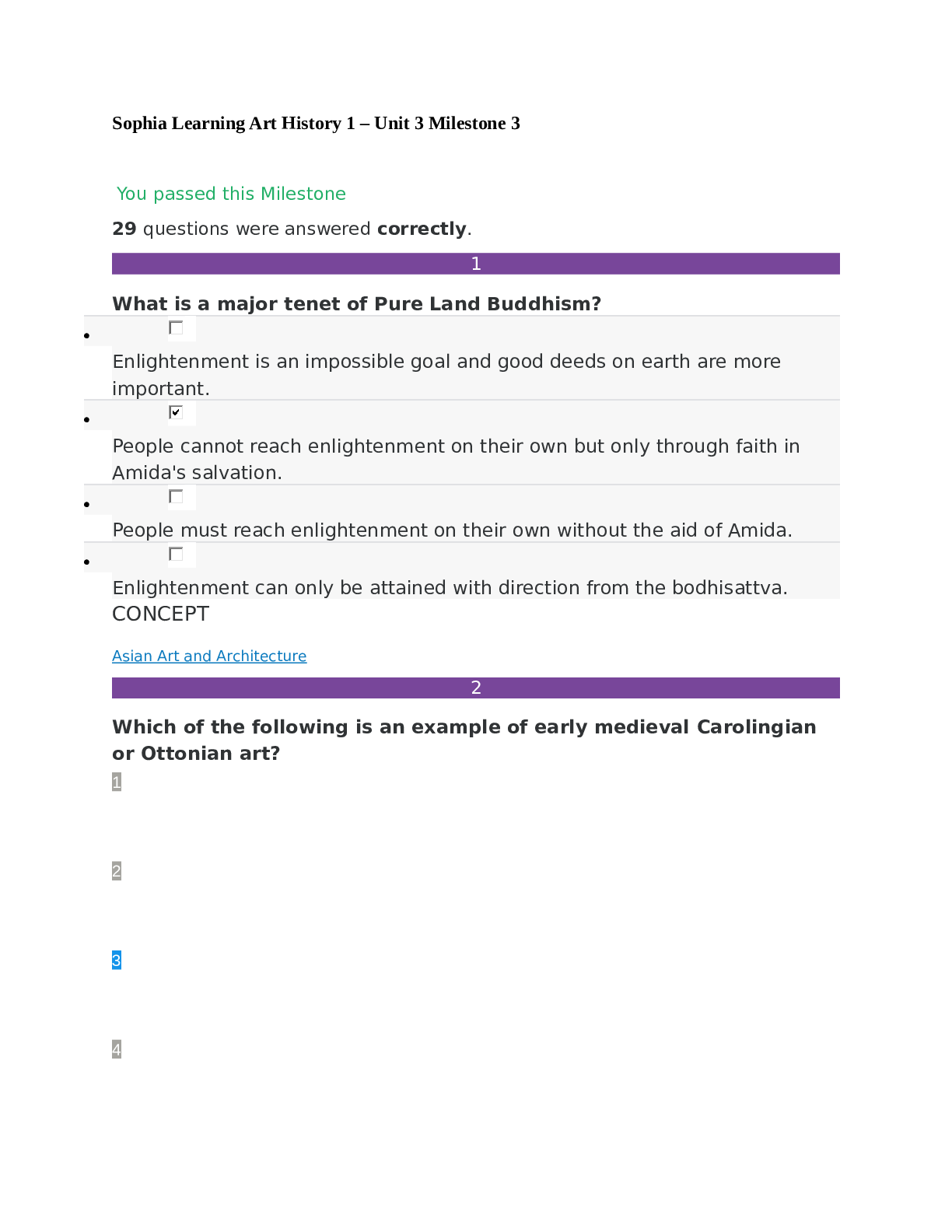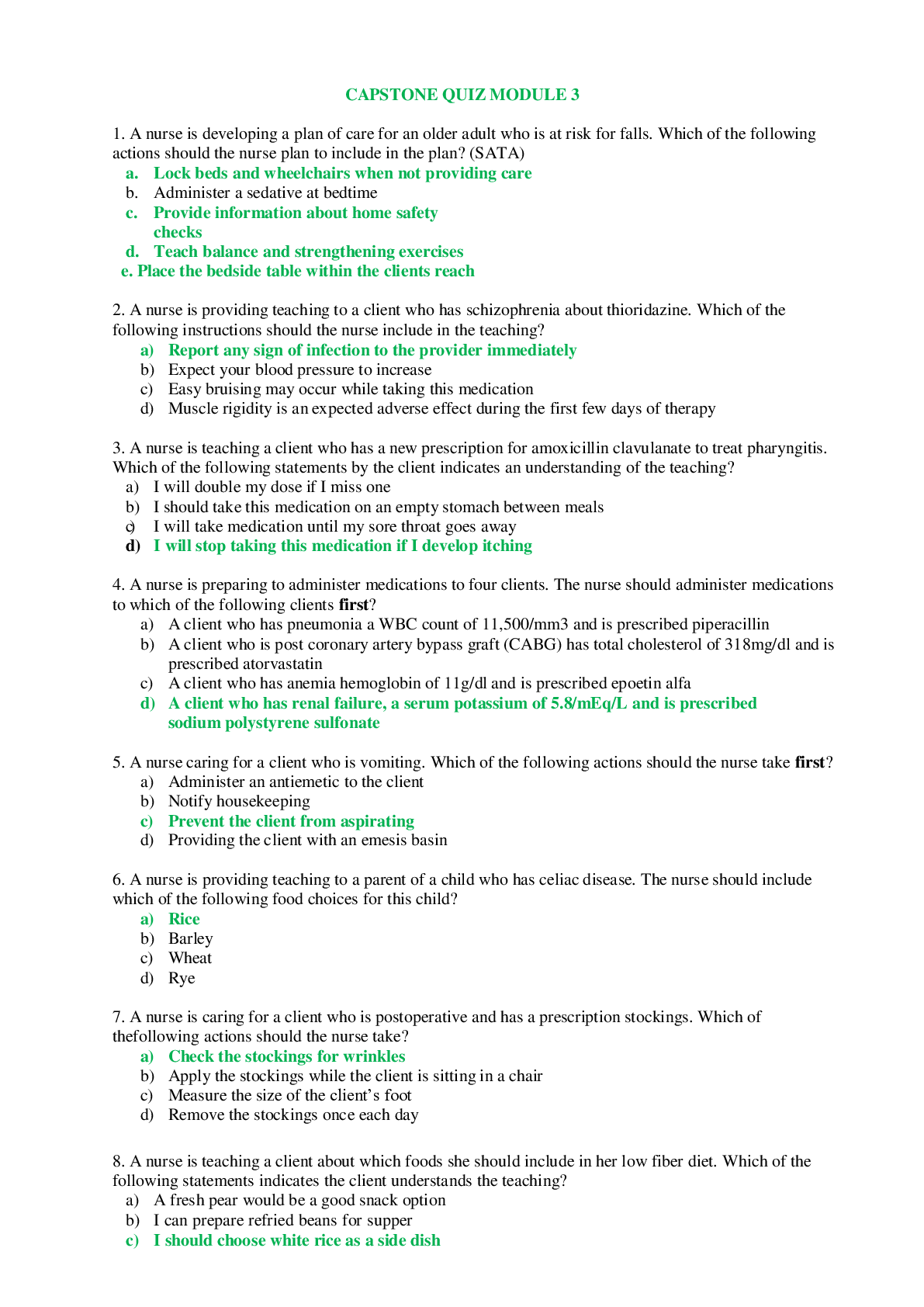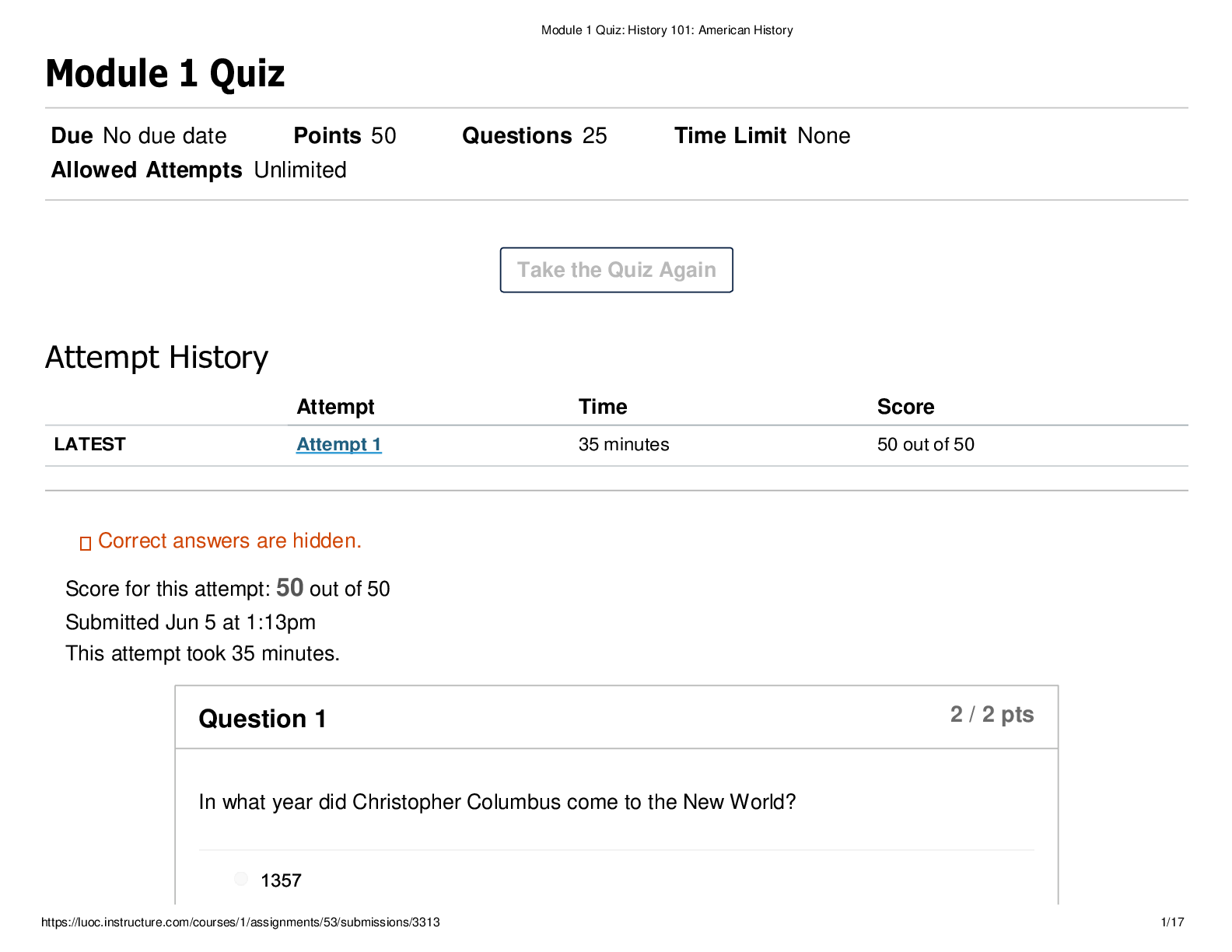Mathematics > EXAM > Fully revised A+ MATH 225N Week 7 Statistics Quiz (Questions & Answers) Summer 2020 Chamberlain (All)
Fully revised A+ MATH 225N Week 7 Statistics Quiz (Questions & Answers) Summer 2020 Chamberlain
Document Content and Description Below
WEEK 7: QUIZ Question 1 2 / 2 pts (CO6) From a random sample of 55 businesses, it is found that the mean time that employees spend on personal issues each week is 5.8 hours with a standard deviati... on of 0.35 hours. What is the 95% confidence interval for the amount of time spent on personal issues? @See text page 301 Correct! (5.71, 5.89) (5.73, 5.87) (5.74, 5.90) (5.72, 5.88) Question 2 2 / 2 pts (CO6) If a confidence interval is given from 8.52 to 10.23 and the mean is known to be 9.375, what is the margin of error? 8.520 1.710ect! 0.855 0.428 Question 3 2 / 2 pts (CO6) If the population standard deviation of a sample decreases without other changes, what is most likely to happen to the confidence interval? @See text page 301 does not change cannot determine narrows widens Question 4 2 / 2 pts (CO6) From a random sample of 85 teens, it is found that on average they spend 31.8 hours each week online with a population standard deviation of 5.91 hours. What is the 90% confidence interval for the amount of time they spend online each week? @See text page 301 (25.89, 37.71) Correct! (30.75, 32.85) (30.62, 32.99) (19.98, 43.62) Question 5 2 / 2 pts (CO6) A company making refrigerators strives for the internal temperature to have a mean of 37.5 degrees with a population standard deviation of 0.6 degrees, based on samples of 100. A sample of 100 refrigerators have an average temperature of 37.53 degrees. Are the refrigerators within the 90% confidence interval? @See text page 301 No, the temperature is outside the confidence interval of (36.90, 38.10) Yes, the temperature is within the confidence interval of (36.90, 38.10) Correct! Yes, the temperature is within the confidence interval of (37.40, 37.60) No, the temperature is outside the confidence interval of (37.40, 37.60) Question 6 2 / 2 pts (CO6) What is the 97% confidence interval for a sample of 104 soda cans that have a mean amount of 12.10 ounces and a population standard deviation of 0.08 ounces? @See text page 301 (12.035, 12.065) (12.083, 12.1217) (12.033, 12.067) You Answered (12.020, 12.180) Question 7 2 / 2 pts (CO6) Determine the minimum sample size required when you want to be 98% confident that the sample mean is within two units of the population mean. Assume a population standard deviation of 7.55 in a normally distributed population. @See text page 304 Correct! 78 76 44 77 Question 8 2 /2 (CO6) Determine the minimum sample size required when you want to be 80% confident that the sample mean is within 1.5 units of the population mean. Assume a population standard deviation of 9.24 in a normally distributed population. @See text page 304 62 146 63 You Answered 145 Question 9 2 /2 (CO6) Determine the minimum sample size required when you want to be 75% confident that the sample mean is within twenty-five units of the population mean. Assume a population standard deviation of 327.8 in a normally distributed population @See text page 304 283 466 661 228 Question 10 2/ 2 pts (CO6) In a sample of 8 high school students, they spent an average of 25.8 hours each week doing sports with a sample standard deviation of 3.2 hours. Find the 95% confidence interval, assuming the times are normally distributed. @See text page 312 (22.60, 29.00) (23.12, 28.48) (23.15, 28.50) (19.40, 32.20) Question 11 2/2 (CO6) In a sample of 15 stuffed animals, you find that they weigh an average of 8.56 ounces with a sample standard deviation of 0.08 ounces. Find the 92% confidence interval, assuming the times are normally distributed. @See text page 312 (8.516, 8.604) (8.528, 8.591) (8.521, 8.599) (8.543, 8.577) Unanswered Question 12 2 / 2 pts (CO6) Market research indicates that a new product has the potential to make the company an additional $3.8 million, with a standard deviation of $1.6 million. If this estimate was based on a sample of 10 customers from a normally distributed data set, what would be the 90% confidence interval? @See text page 312 (2.70, 4.90) (2.81, 4.79) (2.51, 5.09) (2.87, 4.73) Question 13 0 / 2 pts (CO6) Supplier claims that they are 95% confident that their products will be in the interval of 20.45 to 21.05. You take samples and find that the 95% confidence interval of what they are sending is 20.32 to 21.48. What conclusion can be made? @See text pages 298-300 The supplier is more accurate than they claimed The supplier is less accurate than they have claimed The supplier products have a lower mean than claimed The supplier products have a higher mean than claimed Question 14 2 / 2 pts (CO6) In a sample of 18 small candles, the weight is found to be 3.72 ounces with a standard deviation of 0.963 ounces. What would be the 87% confidence interval for the size of the candles, assuming the data are normally distributed? @See text page 312 (3.359, 4.081) (3.337, 4.103) (3.320, 4.120) (3.371, 4.069) Question 15 2 / 2 pts (CO6) In a situation where the population standard deviation was known rather than the sample standard deviation, what would be the impact on the confidence interval? @See text pages 301 and 312 It would become wider due to using the z distribution It would become narrower due to using the z distribution It would become narrower with fewer values It would remain the same as standard deviation does not impact confidence intervals Question 16 2 / 2 pts (CO7) A company claims that its heaters last at most 5 years. Write the null and alternative hypotheses and note which is the claim. @See text page 349 Ho: μ ≤ 5 (claim), Ha: μ > 5 You Answered Ho: μ ≤ 5, Ha: μ > 5 (claim) Ho: μ = 5 (claim), Ha: μ ≥ 5 Ho: μ > 5 (claim), Ha: μ ≤ 5 Question 17 2 / 2 pts (CO7) An executive claims that her employees spend no more than 2.5 hours each week in meetings. Write the null and alternative hypotheses and note which is the claim. @See text page 349 Ho: μ ≤ 2.5 (claim), Ha: μ > 2.5 Ho: μ > 2.5, Ha: μ ≤ 2.5 (claim) Ho: μ ≤ 2.5, Ha: μ < 2.5 (claim) Ho: μ = 2.5 (claim), Ha: μ ≥ 2.5 Unanswered Question 18 2 / 2 pt (CO7) In hypothesis testing, a key element in the structure of the hypotheses is that the alternative hypothesis has the ________________________. @See text page 349 claim equality simple inequality truth Unanswered Question 19 2 / 2 pts (CO7) A landscaping company claims that at least 90% of workers arrive on time. If a hypothesis test is performed that rejects the null hypothesis, how would this decision be interpreted? @See text page 356 There is sufficient evidence to support the claim that more than 90% of workers arrive on time There is sufficient evidence to support the claim that a least 90% of workers arrive on time There is not sufficient evidence to support the claim that more than 90% of workers arrive on time There is not sufficient evidence to support the claim that at least 90% of workers arrive on time Question 20 2/2 (CO7) A textbook company claims that their book is so engaging that more than 55% of students read it. If a hypothesis test is performed that fails to reject the null hypothesis, how would this decision be interpreted? @See text page 356 There is sufficient evidence to support the claim that no more than 55% of students read this text There is not sufficient evidence to support the claim that no more than 55% of students read this text There is sufficient evidence to support the claim that more than 55% of students read this text There is not sufficient evidence to support the claim that more than 55% of students read this text Question 21 2/ 2 pts (CO7) An advocacy group claims that the mean braking distance of a certain type of tire is 75 feet when the car is going 40 miles per hour. In a test of 45 of these tires, the braking distance has a mean of 77 and a population standard deviation of 5.9 feet. Find the standardized test statistic and the corresponding p-value. @See text page 365 z-test statistic = -2.27, p-value = 0.0115 z-test statistic = -2.27, p-value = 0.0230 z-test statistic = 2.27, p-value = 0.0230 z-test statistic = 2.27, p-value = 0.0115 Question 23 2/2 (CO7) A light bulb manufacturer guarantees that the mean life of a certain type of light bulb is at least 720 hours. A random sample of 51 light bulbs as a mean of 701.6 hours with a population standard deviation of 62 hours. At an α=0.05, can you support the company’s claim using the test statistic? @See text pages 368-370 Claim is the alternative, reject the null and support claim as test statistic (-2.12) is not in the rejection region defined by the critical value (-1.96) Claim is the null, reject the null and support claim as test statistic (-2.12) is in the rejection region defined by the critical value (-1.645) Claim is the alternative, fail to reject the null and cannot support claim as the test statistic (-2.12) is in the rejection region defined by the the critical value (-1.96) Claim is the null, fail to reject the null and cannot support claim as test statistic (-2.12) is not in the rejection region defined by the critical value (-1.645) Question 24 2 / 2 pts (CO7) A restaurant claims the customers receive their food in less than 16 minutes. A random sample of 39 customers finds a mean wait time for food to be 15.8 minutes with a population standard deviation of 4.1 minutes. At α = 0.04, what type of test is this and can you support the organizations’ claim using the test statistic? @See text pages 368-370 Claim is the null, reject the null so cannot support the claim as test statistic (-0.30) is in the rejection region defined by the critical value (1.75) Claim is the alternative, fail to reject the null so cannot support the claim as test statistic (-0.30) is not in the rejection region defined by the critical value (-1.75) Claim is the alternative, reject the null so support the claim as test statistic (-0.30) is in the rejection region defined by the critical value (-2.05) Claim is the null, fail to reject the null so support the claim as test statistic (-0.30) is not in the rejection region defined by the critical value (1.75) Question 25 2 / 2 pts (CO7) A manufacturer claims that their calculators are 6.800 inches long. A random sample of 39 of their calculators finds they have a mean of 6.812 inches with a population standard deviation of 0.03 inches. At α=0.08, can you support the manufacturer’s claim using the p value? @See text pages 365-366 Claim is the alternative, reject the null and cannot support claim as p-value (0.006) is less than alpha (0.08) Claim is the null, reject the null and cannot support claim as p-value (0.012) is less than alpha (0.08) Claim is the null, fail to reject the null and support claim as p-value (0.006) is greater than alpha (0.08) Claim is the alternative, fail to reject the null and support claim as p-value (0.012) is less than alpha (0.08) Question 26 2 / 2 pts A travel analyst claims that the mean room rates at a three-star hotel in Chicago is greater than $152. In a random sample of 36 three-star hotel rooms in Chicago, the mean room rate is $163 with a population standard deviation of $41. At α=0.10, what type of test is this and can you support the analyst’s claim using the p-value? @See text pages 365-366 Claim is the null, reject the null as p-value (0.054) is less than alpha (0.10), and cannot support the claim Claim is the alternative, reject the null as p-value (0.054) is less than alpha (0.10), and can support the claim Claim is the alternative, fail to reject the null as p-value (0.054) is less than alpha (0.10), and can support the claim Claim is the null, fail to reject the null as p-value (0.054) is less than alpha (0.10), and cannot support the claim Question 27 2 / 2 pts (CO7) A car company claims that the mean gas mileage for its luxury sedan is at least 24 miles per gallon. A random sample of 7 cars has a mean gas mileage of 23 miles per gallon and a standard deviation of 31.2 miles per gallon. At α=0.05, can you support the company’s claim assuming the population is normally distributed? @See text pages 379-380 No, since the test statistic is in the rejection region defined by the critical value, the null is rejected. The claim is the null, so is not supported Yes, since the test statistic is not in the rejection region defined by the critical value, the null is not rejected. The claim is the null, so is supported No, since the test statistic is not in the rejection region defined by the critical value, the null is not rejected. The claim is the null, so is supported Yes, since the test statistic is not in the rejection region defined by the critical value, the null is not rejected. The claim is the null, so is supported Question 28 2 / 2 pts (CO7) A state Department of Transportation claims that the mean wait time for various services at its different location is less than 6 minutes. A random sample of 16 services at different locations has a mean wait time of 9.5 minutes and a standard deviation of 7.6 minutes. At α=0.01, can the department’s claim be supported assuming the population is normally distributed? @See text page 382 Yes, since p of 0.043 is greater than 0.01, fail to reject the null. Claim is null, so is supported No, since p of 0.043 is greater than 0.01, reject the null. Claim is null, so is not supported No, since p of 0.043 is greater than 0.01, fail to reject the null. Claim is alternative, so is not supported Yes, since p of 0.043 is less than 0.09, reject the null. Claim is alternative, so is supported Question 29 2/ 2 pts (CO7) A used car dealer says that the mean price of a three-year-old sport utility vehicle in good condition is $18,000. A random sample of 20 such vehicles has a mean price of $18,450 and a standard deviation of $1860. At α=0.08, can the dealer’s claim be supported assuming the population is normally distributed? @See text pages 379-380 Yes, since the test statistic of 1.08 is not in the rejection region defined by the critical value of 1.85, the null is not rejected. The claim is the null, so is supported No, since the test statistic of 1.08 is close to the critical value of 1.24, the null is not rejected. The claim is the null, so is supported No, since the test statistic of 1.08 is in the rejection region defined by the critical value of 1.85, the null is rejected. The claim is the null, so is not supported Yes, since the test statistic of 1.08 is in the rejection region defined by the critical value of 1.46, the null is rejected. The claim is the null, so is supported Question 30 2 / 2 pts (CO7) A researcher wants to determine if daily talks together strengthen a marriage. One group of wives and one group of husbands are selected and have daily talks. After 2 weeks, all are asked if they felt their marriage was stronger based on the talks and the results of the two groups are compared. To be a valid matched pair test, what should the researcher consider in creating the two groups? @See text page 418 That the husbands and wives selected were married to each other That all husbands and wives in the test had been married about the same amount of time That the both groups were positive on marriage before the walks That the wives group was positive on marriage before the walks [Show More]
Last updated: 1 year ago
Preview 1 out of 19 pages
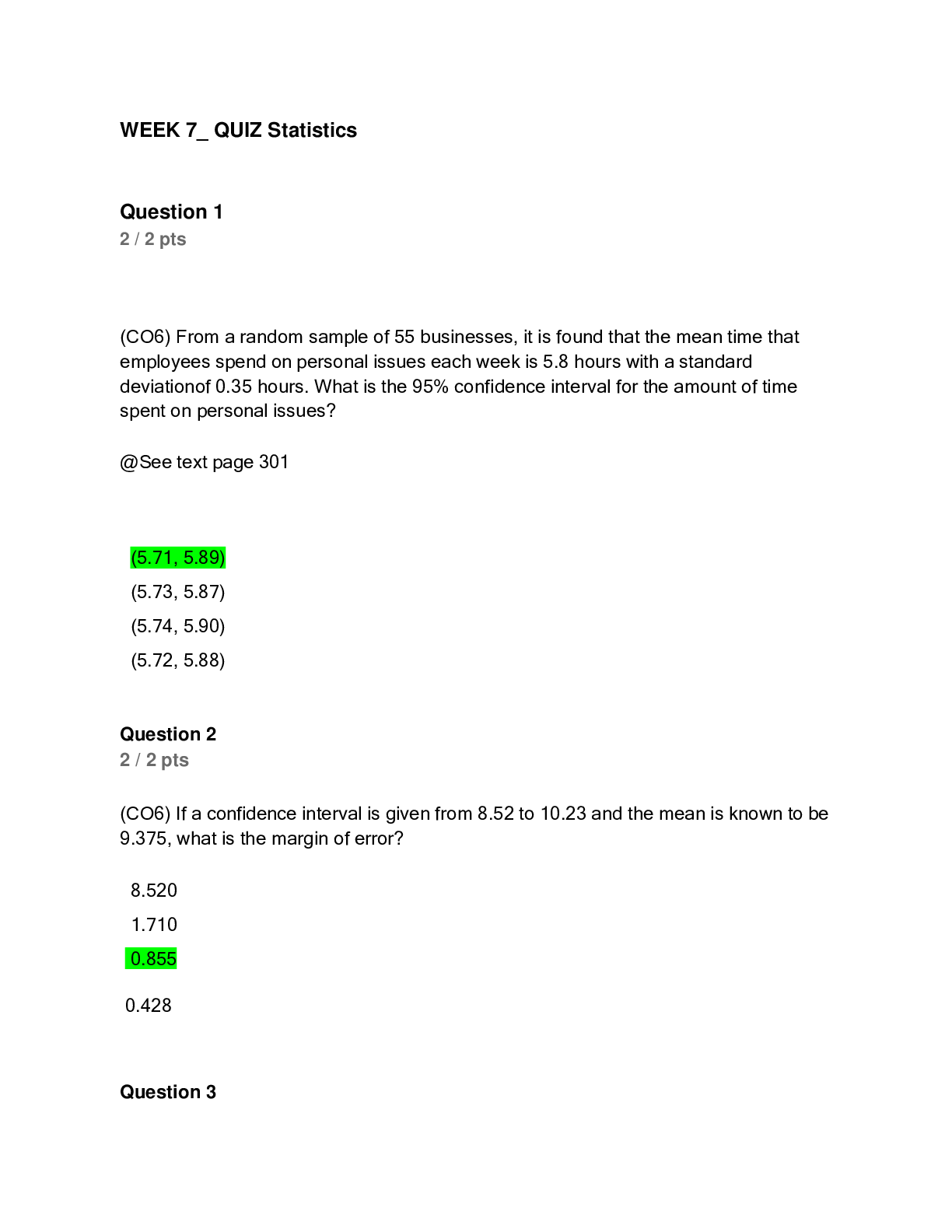
Buy this document to get the full access instantly
Instant Download Access after purchase
Add to cartInstant download
We Accept:

Reviews( 0 )
$15.00
Document information
Connected school, study & course
About the document
Uploaded On
Jun 14, 2021
Number of pages
19
Written in
Additional information
This document has been written for:
Uploaded
Jun 14, 2021
Downloads
0
Views
67

